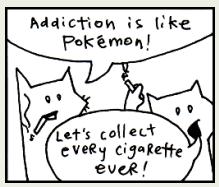
Are we offloading our brains onto the web? Are programs better than teachers at knowing what we know? Do virtual badges motivate more than grades? What is it about cartoon foxes that helps us learn to code? As you can read in our piece “How the Internet Revolutionized Education”, we’ve been tracking on-line education closely for some time now– talking to experts and keeping tabs on an industry that’s exploding as predicted. Over here at the science desk, recent developments on the learning brain are meshing with what we already know of the web’s power to teach.
We’ve analyzed here four different special powers of online teaching that make brains very happy. Read on to see why curing code-o-phobia is just the beginning…
1) Memory: This is your brain on-line. We mean, this, right now, what you’re reading. It’s your brain. On-line.
According to Columbia neuroscientist Betsy Sparrow and her team, “We are becoming symbiotic with our computer tools”. When participants in Dr. Sparrow’s studies thought a fact was saved somewhere accessible, they’d forget it. Furthermore, the more difficult a question was, the more likely participants were to think of the Internet, rather than actually try to work out an answer on their own.

So is offloading our brain making us dumber? Not according to rising edusoftware giant Knewton’s David Kuntz:
“Accessibility [of information] changes the relative importance of certain topics in much the same ways that a calculator changes the relative importance of some things.”
Kuntz, who’s V.P. of research at the fast growing adaptive learning company, explained that fields of knowledge that were off-loaded simply left room for cogitation on other topics.
“Long division, for example, is a process that, in my opinion, is more or less irrelevant, you never have to work through a problem in that way.”
Our dependence on the web for facts might even be making us smarter. UCLA neuroscientist and author Gary Small did an exploratory fmri study and found that the web-surfer’s googling “may actually engage a greater extent of neural circuitry” than paper-based complex reasoning.
So we’re off-loading our memories to the internet, but when we need to learn a challenging technique, like coding, it takes more than data storage to help us – it takes a smile.
2) Avatars: Why cartoon foxes and emoticons help us learn ;-)
 Our goals and motivations are nothing if not emotional, and computer and neuroscientists are discovering how emotionally attuned electronic characters, from foxes to paper clips (ugh clippy) to the simple smiley can make a big impact on learning. Researchers from Spain are showing how electronic “judges” that provide meaningful feedback dramatically impact learning. Code School’s use of Why’s (his full name name is “Why the Lucky Stiff”, “Who’s” still on first) poignant chunky-bacon-loving foxes helps calm the nerve-wracked codophobe. The brain, especially its fusiform face area, has been shown to be wired to give emotional responses to facial expressions. Scientist Jesús Ibáñez measures this emotional response and recently found that we respond to barely perceptible expressions such as the slightest smile.
Our goals and motivations are nothing if not emotional, and computer and neuroscientists are discovering how emotionally attuned electronic characters, from foxes to paper clips (ugh clippy) to the simple smiley can make a big impact on learning. Researchers from Spain are showing how electronic “judges” that provide meaningful feedback dramatically impact learning. Code School’s use of Why’s (his full name name is “Why the Lucky Stiff”, “Who’s” still on first) poignant chunky-bacon-loving foxes helps calm the nerve-wracked codophobe. The brain, especially its fusiform face area, has been shown to be wired to give emotional responses to facial expressions. Scientist Jesús Ibáñez measures this emotional response and recently found that we respond to barely perceptible expressions such as the slightest smile.
He measured responses to curvey lines, like this one:

Personality matters too, and researchers led by University of Memphis scientist Sidney D’Mello are creating different computer tutors and discovering how their degree of emotional sensitivity can strongly improve learning and motivation. If you make a robot teacher, though, just make sure it doesn’t promise more understanding than it can deliver. These Japanese kids don’t seem to fear the infamous robot teacher Saya despite her propensity for anger.

While explaining the impact even a simple emoticon can have, Ibanez warns that, “The danger of employing animated virtual characters is that wrong expectations are easily generated.” This is probably why most of us prefer R2D2, despite his naughtiness, to the phone-banking-androids who are sorry they didn’t understand our response. So if we’re going to actually spend time learning on-line, what’s really in it for us, besides a robo-smile?
3) Rewards: Badges? Badges?! Some of us need them.
Will code for badges, is what Code School, Knewton, Codecademy and others have discovered about a user base that’s often hungry for achievements and social recognition.
“Facebook use is motivated by two primary needs: (1) the need to belong and (2) the need for self-presentation,” writes Boston University doctors Nadkarni and Hofmann in a recent review.
The “Badge” phenomenon made famous by Foursquare and Wikipedia is, as far as the brain’s reward pathways are concerned, a real thing. In fact, virtual rewards are often more valuable than rewards in the real world. Researchers at Yahoo’s “Internet Experiences Group” wrote recently about how badges provide status, reputation, goals and a sense of collectivity.

As badge use becomes widespread, Gregg Pollack, co-founder of Code School, pointed out that “different people are motivated by different things”. While he’s pretty much “immune to badges” Pollack noted that social broadcasting of achievements has been a major related factor in successful outcomes with Code School.
Cognitive Psychologist Dan Ariely puts badges and social recognition in the category of “conceptual consumption” and has found that people regularly value virtual goods as high, if not higher, than material ones. So how do we know which badges to dangle before which students?
4) Attention: Tell me more about me
Finally, the individualized metrics available from computer teaching is what promises to have the greatest impact on the future of learning by keeping us in our seat and paying attention. The frontal cortex and other specific brain regions are active when we pay in attention in ways that help us learn. Our attention is fickle, and the right challenge at the right time helps capture and channel that attention.

Dynamic learning platforms like Knewton track a variety of measurements in addition to basic progress and can create detailed learning profiles for each student. Moreover, e-learners can actually help both the cold-blooded algorithms and warm-blooded teachers develop a clearer picture of how individual students should be nudged. Kuntz talked enthusiastically about the individualized instruction that on-line learning makes possible, especially when combined with traditional classroom teaching:
“…blended learning platforms with straightforward dashboards… can help identify to teachers what it is that each student needs, which explanations work for which students, and how to provide the right level of challenges”.
Better metrics can help all teachers be like those we remember best, the ones, Kuntz noted, that “intuitively gleam what the student needs… and generate that ‘ah ha!’ moment”.
I think I can (code)
NYC’s startup Codecademy got 200,000 users within its first week through badge-driven growth, showing the hunger for good, social, interactive e-learning content.
Growth continues as notables like Mayor Mike Bloomberg sign up for, and tweet about, the company’s Code Year. As we saw in 2011 from Stickery, Bloc, Kiboomu and more, learning guides, badges and individualization are becoming more ubiquitous as appetites for social goods are growing. We’ve seen how neuroscientists from across the globe are connecting revolutionary software with revolutionary theories of how the brain learns. But can all this brain candy cure your (or your mom’s) code-o-phobia? Click the foxes and Try Ruby – and then tell us what you think.
Get the TNW newsletter
Get the most important tech news in your inbox each week.






